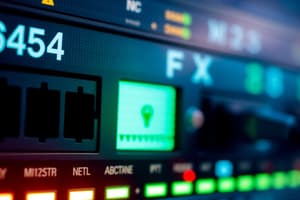Podcast
Questions and Answers
What is the main issue with timestamps on different nodes in a distributed system?
What is the main issue with timestamps on different nodes in a distributed system?
- Clock drift can make them meaningless (correct)
- They can be relied upon to determine order
- They are always accurate
- They are universally standardized
Clock drift does not impact the reliability of event timestamps in distributed systems.
Clock drift does not impact the reliability of event timestamps in distributed systems.
False (B)
What is the title of the book by George Coulouris that covers distributed systems?
What is the title of the book by George Coulouris that covers distributed systems?
Distributed Systems: Concepts and Design
The implications of clock drift will become clear when discussing __________ in detail.
The implications of clock drift will become clear when discussing __________ in detail.
Match the following authors with their contributions:
Match the following authors with their contributions:
What is the maximum packet size when data is streamed over TCP?
What is the maximum packet size when data is streamed over TCP?
TCP ensures that packets arrive in the exact order they were sent.
TCP ensures that packets arrive in the exact order they were sent.
What mechanism does TCP use to acknowledge packet receipt?
What mechanism does TCP use to acknowledge packet receipt?
TCP trades off ______ for reliability.
TCP trades off ______ for reliability.
Which protocol is described as connectionless and prioritizes raw performance?
Which protocol is described as connectionless and prioritizes raw performance?
Match the following TCP features with their descriptions:
Match the following TCP features with their descriptions:
UDP guarantees delivery of packets in the order they are sent.
UDP guarantees delivery of packets in the order they are sent.
What happens if a sender does not receive an acknowledgment within a timeout period?
What happens if a sender does not receive an acknowledgment within a timeout period?
What is the main reason IPv4 is being replaced by IPv6?
What is the main reason IPv4 is being replaced by IPv6?
IPv6 is based on a 32-bit addressing scheme.
IPv6 is based on a 32-bit addressing scheme.
What is the role of a root DNS server?
What is the role of a root DNS server?
The local DNS server remembers the IP addresses of recently contacted ______.
The local DNS server remembers the IP addresses of recently contacted ______.
Which of the following is true about DNS servers?
Which of the following is true about DNS servers?
What do the packet headers in an IP network contain?
What do the packet headers in an IP network contain?
Match the following DNS components with their functions:
Match the following DNS components with their functions:
An IPv4 address is a ______-bit addressing scheme.
An IPv4 address is a ______-bit addressing scheme.
What is the primary purpose of an interface such as IGBank in software engineering?
What is the primary purpose of an interface such as IGBank in software engineering?
Java Remote Method Invocation (RMI) allows for non-Java applications to communicate effectively.
Java Remote Method Invocation (RMI) allows for non-Java applications to communicate effectively.
List one major feature of Distributed Computing Environment (DCE) RPC.
List one major feature of Distributed Computing Environment (DCE) RPC.
CORBA facilitates __________ client/server communications based on an object-oriented interface definition language.
CORBA facilitates __________ client/server communications based on an object-oriented interface definition language.
Which language supports Java Remote Method Invocation (RMI)?
Which language supports Java Remote Method Invocation (RMI)?
Match the following technologies with their main features:
Match the following technologies with their main features:
The advantages of explicit interfaces in distributed systems have been recognized since the early 1990s.
The advantages of explicit interfaces in distributed systems have been recognized since the early 1990s.
What is the main advantage of using Remote Procedure Call (RPC) technologies?
What is the main advantage of using Remote Procedure Call (RPC) technologies?
What is the main problem described in the Two Generals' Problem?
What is the main problem described in the Two Generals' Problem?
In the Two Generals' Problem, the first general can guarantee that the second general receives the attack instructions.
In the Two Generals' Problem, the first general can guarantee that the second general receives the attack instructions.
What is the FLP Impossibility Theorem concerned with?
What is the FLP Impossibility Theorem concerned with?
To increase the likelihood of message delivery, each general in the Two Generals' Problem may send multiple __________.
To increase the likelihood of message delivery, each general in the Two Generals' Problem may send multiple __________.
Match the following terms with their descriptions:
Match the following terms with their descriptions:
What practical solution can increase consensus in distributed systems despite message delays?
What practical solution can increase consensus in distributed systems despite message delays?
In a distributed system, it is essential for each node to be online at all times to ensure consensus.
In a distributed system, it is essential for each node to be online at all times to ensure consensus.
Why might messages between generals get lost or delayed?
Why might messages between generals get lost or delayed?
Flashcards
IPv4
IPv4
A 32-bit addressing scheme for internet addresses. It's running out of addresses.
IPv6
IPv6
A 128-bit successor to IPv4 offering near-infinite IP addresses
DNS
DNS
Hierarchical system for translating domain names (like google.com) to IP addresses
Packet Switching
Packet Switching
Signup and view all the flashcards
TCP
TCP
Signup and view all the flashcards
UDP
UDP
Signup and view all the flashcards
RPC
RPC
Signup and view all the flashcards
Two Generals' Problem
Two Generals' Problem
Signup and view all the flashcards
Clock Drift
Clock Drift
Signup and view all the flashcards
Asynchronous
Asynchronous
Signup and view all the flashcards
Explicit Interfaces
Explicit Interfaces
Signup and view all the flashcards
Root DNS Servers
Root DNS Servers
Signup and view all the flashcards
Authoritative DNS Server
Authoritative DNS Server
Signup and view all the flashcards
Local DNS server
Local DNS server
Signup and view all the flashcards
Study Notes
Internet Protocol
- IPv4 is a 32-bit addressing scheme that will soon run out of addresses, due to the number of devices connecting to the internet
- IPv6 is a 128-bit successor to IPv4 and will offer an (almost) infinite number of IP addresses
- In July 2020 about 33% of the traffic processed by Google.com was IPv6
DNS
- DNS servers are organized hierarchically
- A small number of root DNS servers are the starting point for resolving an IP address
- When an internet browser tries to find a website, a local DNS server contacts a root DNS server
- The root server replies with a referral to an authoritative DNS server
- An authoritative name server manages name resolution for each top-level internet domain (.com, .org, .net, etc.)
- The local DNS server queries the appropriate top-level domain server
- The top-level DNS server replies with the address of the DNS server that knows about all the IP addresses for the website
- This DNS server is queried, and it returns the actual IP address for the website
Packet Switching
- IP defines a packet structure that contains the data to be delivered, along with source and destination IP addresses
- The internet is a packet-switched network, which means that every packet is individually routed across the network
- The route each packet traverses can vary dynamically based on the conditions in the network, such as link congestion or failure
- This means that packets may not arrive at the server in the same order they are sent from the client
TCP
- TCP uses a cumulative acknowledgment mechanism to ensure reliable packet delivery
- A receiver will periodically send an acknowledgment packet that contains the highest sequence number of the packets received without gaps
- This implicitly acknowledges all packets sent with a lower sequence number
- If a sender doesn't receive an acknowledgment within a timeout period, the packet is resent
- TCP also uses checksums to check packet integrity
- TCP performs dynamic flow control to ensure a sender doesn't overwhelm a slow receiver by sending data too quickly
UDP
- UDP is a simple, connectionless protocol, which exposes the user's program to any unreliability of the underlying network
- UDP offers raw performance instead of reliability
Explicit Interfaces
- Interfaces can be used to define explicit server interfaces that can be called across the network using the same syntax as a sequential program
- Explicit interfaces are generally considered a good practice in software engineering
- The benefits of explicit interfaces are well known in software engineering and are one of the foundations of object-oriented design
Remote Procedure Call (RPC)
- RPC technologies allow programmers to define explicit server interfaces and call them across the network
- Some RPC technologies are:
- Distributed Computing Environment (DCE): A standardized approach for client/server systems, primary languages were C/C++
- Common Object Request Broker Architecture (CORBA): Facilitates language-neutral client/server communications based on an object-oriented interface definition language (IDL), primary languages include: C/C++, Java, Python, and Ada
- Java Remote Method Invocation (RMI): A pure Java-based remote method invocation that facilitates distributed client/server systems with the same semantics as Java objects.
The Two Generals' Problem
- The Two Generals' Problem is a classic example of the challenges of reaching consensus in distributed systems
- The problem illustrates the difficulties of reaching agreement in the presence of unreliable communication
- Partial failures are analogous to losing messages and acknowledgments in a distributed system
- Message delays are unavoidable due to asynchronous networks
- The FLP Impossibility Theorem demonstrates an asynchronous network in the presence of crash faults (messages can be delayed but not lost), it is impossible to achieve consensus within bounded time
Clock Drift
- Our applications cannot rely on timestamps of events on different nodes to represent the actual order of these events
- Clock drift makes cross-node timestamps meaningless to compare
- The implications of clock drift will be clearer when we start to discuss distributed databases in detail
Network Fundamentals Summary
- Networks are asynchronous, which means that the speed of communication can vary unpredictably.
- Message delays are unpredictable in asynchronous networks.
- Partial failures in asynchronous networks are difficult to manage, as messages can be lost or delayed.
- Reaching consensus on an asynchronous network in the presence of failures is a challenging problem, but not impossible with the right approach.
- Clock drift (time discrepancies between systems) can disrupt the accuracy of timestamps for events in distributed systems.
Studying That Suits You
Use AI to generate personalized quizzes and flashcards to suit your learning preferences.





